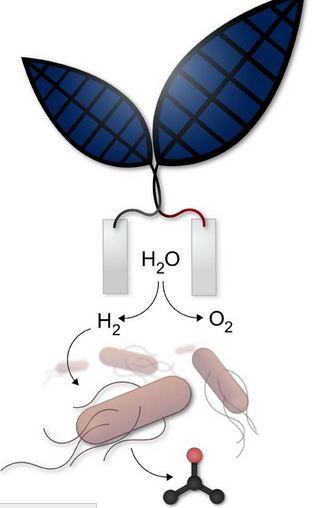Scientists have created a system that uses genetically modified bacteria to convert solar energy into liquid fuel.
Their work integrates an "artificial leaf" that uses a catalyst to make sunlight split water into hydrogen and oxygen with the help of a bacterium engineered to convert carbon dioxide plus hydrogen into the liquid fuel, isopropanol, according to the Harvard Medical School.
Isopropanol or isopropyl alcohol is a liquid alcohol that can be burned as fuel, said NBC News. Today, however, isopropanol is commonly used as a household disinfectant and as an industrial drying agent to remove water from fuels.
A team from Harvard University's Faculty of Arts and Sciences, Harvard Medical School (HMS) and the Wyss Institute for Biologically Inspired Engineering succeeded in this task.
In this new system, once the artificial leaf produces oxygen and hydrogen, the hydrogen is fed to a bacterium called Ralstonia eutropha. An enzyme takes the hydrogen back to protons and electrons then combines them with carbon dioxide to replicate--making more cells.
Next, new pathways in the bacterium are metabolically engineered to make isopropanol.
"This is a proof of concept that you can have a way of harvesting solar energy and storing it in the form of a liquid fuel," said Pamela Silver, Professor of Biochemistry and Systems Biology at HMS.
"It's not like we're trying to make some super-convoluted system. Instead, we are looking for simplicity and ease of use."
The artificial leaf invented by the paper's senior author, Daniel Nocera, Professor of Energy at Harvard University, depends on catalysts made from inexpensive but readily materials.
"The catalysts I made are extremely well adapted and compatible with the growth conditions you need for living organisms like a bacterium," Nocera said.
The team's pressing challenge is to increase the bionic leaf's ability to translate solar energy to biomass by optimizing the catalyst and the bacteria. Their goal is five percent efficiency, compared to nature's rate of one percent efficiency for photosynthesis to turn sunlight into biomass.
"We're almost at a 1 percent efficiency rate of converting sunlight into isopropanol," Nocera said.
If successful, the bionic leaf can be an efficient method of producing renewable energy and, therefore, fighting climate change.




























